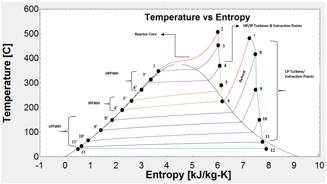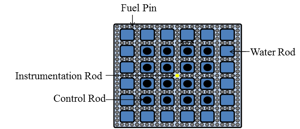The main focus of this project is to produce a working schematic for a Generation IV Supercritical Water Reactor that is a competitive alternative to current methods of nuclear power production.Supercritical water is chosen as the coolant as its properties allow for the reactor to reach higher efficiencies that are out of a typical PWR’s range. Supercritical water means that the operating conditions for this reactor will be that of, or greater than pressures of 22.06MPa and temperatures of 327C. The reactor utilizes unique solutions to the complexity of supercritical water, such as in order to maintain equal cooling and moderation of the core downflow rods are emplaced. This project was broken up into three subsystems including the thermodynamic subsystem, fuel assembly subsystem, and the fuel rod subsystem. Over the course of the semesters each person in the group had an assigned subsystem and came up with their own designs. Upon final design the subsystems were brought into one final working design through the use of ESS.
Team: Levi Rosa, Troy Violette, Matt Zimmer, Kevin Downey
Project Advisor: Dr. Michael Podowski

Project Motivation
The global increase in power demand has led to the search for improved designs of nuclear reactors to meet the higher standards set by international and federal committees and to meet keep up with the demand by increasing power production and efficiency without compromising safety. This has led to the design of the Generation IV nuclear reactors, one of which is the Supercritical Water Reactor (SCWR). The SCWR operates at a higher temperature and pressure increasing the overall efficiency of the cycle. With nuclear power struggling to sustain itself in an ever evolving energy market it is of the utmost importance to evaluate and improve upon future options to make nuclear power a viable and safe alternative to inefficient and costly current methods of power production. With future funding, research, and advances in materials engineering we believe SCWR’s are one of the most viable and lucrative Generation IV Nuclear designs to date.

Project Description
The main focus of this project is to produce a working schematic for a Generation IV Supercritical Water Reactor that is a competitive alternative to current methods of nuclear power production.Supercritical water is chosen as the coolant as its properties allow for the reactor to reach higher efficiencies that are out of a typical PWR’s range. Supercritical water means that the operating conditions for this reactor will be that of, or greater than pressures of 22.06MPa and temperatures of 327C. The reactor utilizes unique solutions to the complexity of supercritical water, such as in order to maintain equal cooling and moderation of the core downflow rods are emplaced. This project was broken up into three subsystems including the thermodynamic subsystem, fuel assembly subsystem, and the fuel rod subsystem. Over the course of the semesters each person in the group had an assigned subsystem and came up with their own designs. Upon final design the subsystems were brought into one final working design through the use of ESS.

Results and Accomplishments
EES was used to generate mathematical models for each of the three subsystems, fuel rod/neutronics, thermodynamics, and fuel assembly, that compose the overall design. The neutronics model showed that the proposed fuel assembly geometry was feasible in producing a keff realistic to a nuclear reactor. The thermodynamic model was used to determine the efficiency of the system by analyzing the thermal properties of the coolant as it passed through the condensers, pumps, turbines, etc. The fuel assembly model accounted for the properties and operating conditions of the fuel assembly and coolant. The combination of these models creates an effective overall model of a supercritical water reactor and allowed for determination of optimal operating conditions. The result of the analysis was to design the reactor to operate at 25.5 MPa with a mass flow rate of 2250 kg/s, as well as the fuel assembly design of the INL reactor and the thermodynamic design of the Korean reactor. the proposed reactor has an efficiency of 45.3%, which is 3.0% higher than already existing SCWR conceptual designs. Therefore the proposed design has, based on the simplified models, improved upon existing designs.